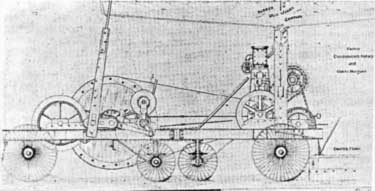 |
||||||
Combination Rig
This type of portable rig allowed the use of two major drilling procedures, the cable tool and the rotary system, both on the same machine. Drillers had noticed that the percussion or cable tool drilling method was not too effective in soft formations such as are found in the Gulf Coastal Plain. Cable tool did well in harder rocks as present in the Appalachian basin. Rotary drilling with roller-cutter and fishtail bits did better in the shales and siltstones of the soft formations. Rotary drilling in America dates to patents and experiments in the 1860's. The use of rotary in the Corsicana field in Texas in 1895 and shortly after is generally credited as the first significant application of that system in oil well drilling, but water well drilling by rotary goes back much farther. The famous Lucas well at Spindletop in Texas was drilled by rotary tools with table, drawworks, mud-laden fluid and an Oil Well Supply steam engine in 1900. This great gusher brought the rotary system of drilling to the attention of all oilmen, but the cable tool method remained successful in the harder rock provinces. As it turns out, there were some in-between regions too, both geographically and vertically in the stratigraphic section. In other words, a given site, say in California, might have hard rock and soft rock in the same sedimentary section posing a problem for both rotary and cable tool. Such sections could be effectively drilled with a combination rig in those days.
The combination rig essentially had a rotary drawworks and engine on one side and the familiar band wheel, walking beam etc. on the other side. The complete apparatus gave the driller the discretion to use either one of the two drilling methods which he could pick on the basis of penetration rate. This option gave a boost to the theoretical versatility of the drilling machine. Within a short time after the discovery at Spindletop portable combination machines were available. However, they were said to be cumbersome and tricky. At times two drillers were necessary, one skilled in cable tool and the other in rotary. The latter was the "new kid on the block" and the other, the cable tool man, was usually a long ways away (Pennsylvania). So the first portable combination rigs were costly to operate from a labor standpoint.
The growing application of rotary drilling required a multitude of improvements and inventions. The combination rig eventually gave way to fully rotary machines. The cable tool rigs continued to work in their customary domains and some are still at work today.
|
||
|
![]()
| © 2004, Samuel T. Pees all rights reserved |
|

